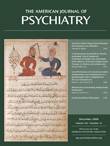Oxcarbazepine and Pediatric Bipolar Disorder
To the Editor: In reference to the article by Karen Dineen Wagner, M.D., Ph.D., et al. (1) , two issues need clarification regarding 1) generalizability of the study results and 2) issues of comorbidity and combination therapy.
First, in Table 1, the authors reported that the mean number of manic/hypomanic episodes ranged between 15.1–17.1 in the past year of the illness in the groups randomly assigned to oxcarbazepine and placebo, respectively. This seems to be in significant variance with the cohort recruited for the basic descriptive psychopathology study by Geller et al. (2) , where, using arguably the best available state-of-the-art diagnostic methods and operationalized definitions of episodes and “cycling,” the index episode of mania at intake had a mean duration of 3.5 years, and there were no subjects characterized as “rapid cyclers” (four or more mood episodes per year), but the vast majority of subjects had ultrarapid cycling or ultradian cycling within a single prolonged episode. The average age of the study subjects is not dissimilar, and the male predominance in the two studies is quite similar. Are we left to conclude that the study subjects are in fact composed of different phenotypes of mania or bipolar disorder? Or is there a difference in the way terms such as “episodes” or “cycles” are being used, reflecting disagreement between research groups? Do the authors have suggestions regarding terminology so that interested readers can make informed comparisons between studies regarding the description of basic research subject characteristics?
Second, it is noted that about one-third of subjects in each group remained on “stable stimulant therapy” from screening through the end of the study. Was any consideration given to a concern that stimulant therapy may have been making the mood episode worse or more unstable? If so, why, as a preliminary step, weren’t subjects required to discontinue from stimulant therapy prior to randomization to observe the effect of this intervention on the overall mood state? Many clinicians believe that safe and effective use of psychostimulant therapy in pediatric patients with comorbid ADHD and mania requires effective mood stabilization prior to use of stimulant therapy (3) . Could the authors review their data and report on whether concurrent treatment with stimulants affected baseline ratings of psychopathology or had a predictive, moderating, or mediating effect on the data through the course of the trial?
1. Wagner KD, Kowatch RA, Emslie GJ, Findling RL, Wilens TE, McCague K, D’Souza J, Wamil A, Lehman RB, Berv D, Linden D: A double-blind, randomized, placebo-controlled trial of oxcarbazepine in the treatment of bipolar disorder in children and adolescents. Am J Psychiatry 2006; 163: 1179–1186Google Scholar
2. Geller B, Tillman R, Craney JL, Bolhofner K: Four-year prospective outcome and natural history of mania in children with a prepubertal and early adolescent bipolar disorder phenotype. Arch Gen Psychiatry 2004; 61:459–67Google Scholar
3. Scheffer RE, Kowatch RA, Carmody T, Rush AJ: Randomized, placebo-controlled trial of mixed amphetamine salts for symptoms of comorbid ADHD in pediatric bipolar disorder after mood stabilization with divalproex sodium. Am J Psychiatry 2005; 162:58–64Google Scholar



